5 Common Eye Problems in Arizona

There are many overall eye conditions that are more common than you think. If you suddenly develop blurry vision, notice floaters in your field of vision, or have chronically dry eyes, chances are there are others experiencing the same symptoms. Eye care specialists in Mesa and Chandler have put together this guide to the symptoms, causes and treatment of common eye problems such as dry eyes, refractive errors, cataracts, glaucoma and age-related macular degeneration. If you believe you have any of the conditions below, make an appointment at Swagel Wootton Eye Institute. Although we specialize in cataract and LASIK eye surgery in the Phoenix area, our highly qualified eye doctors provide comprehensive vision care.
1. Dry Eyes
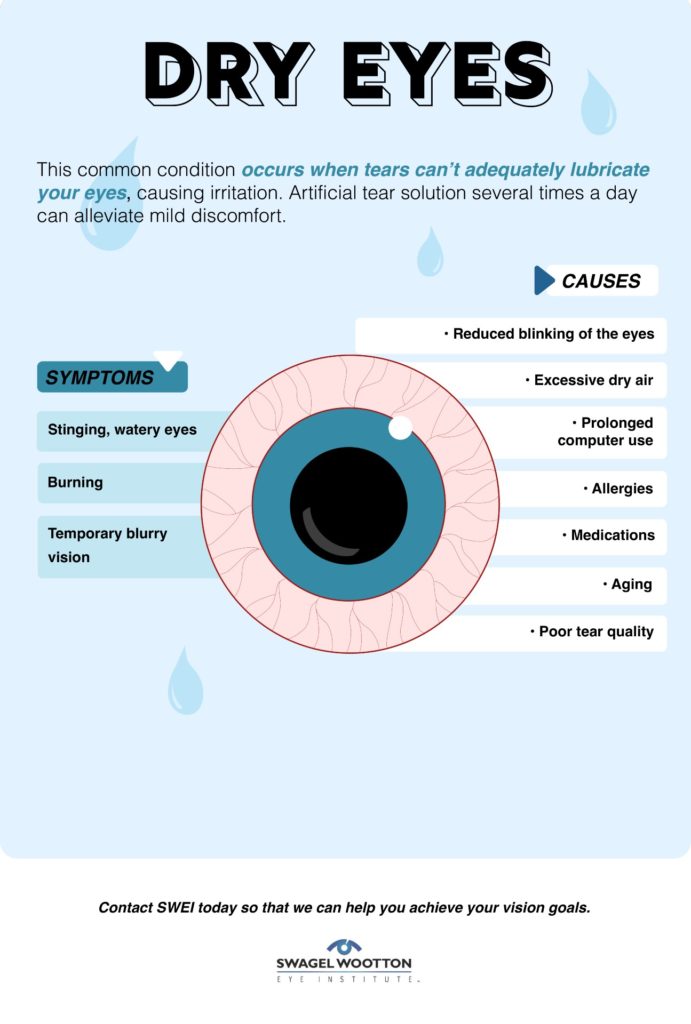
If you experience chronic dry eyes, you can get the right treatment to find relief. Review the symptoms, causes and treatment options available below.
Symptoms of Dry Eyes
You may experience chronic or temporary symptoms such as:
- Stinging, watery eyes
- Burning
- Temporary blurry vision
Causes of Dry Eyes
The potential causes of dry eyes include:
- Prolonged computer use
- Excessive dry air
- Aging
- Hormonal changes in women
- Reduced blinking of the eyes
- Allergies
- Medications
- Laser eye surgery
- Contact lenses
- Poor tear quality
Treatment of Dry Eyes
At Swagel Wootton, we have several treatment options available for dry eyes. Serum tears made directly from your DNA can alleviate the symptoms of dry eyes. Prescription eye drops provide additional lubrication when you need it. Our dedicated staff will work with you to find the treatment method or combination of methods that make the most sense for your lifestyle.
Having dry eye syndrome can leave you with burning, itchy eyes, especially if you’re on the computer a lot. Fortunately, our eye care specialists in Mesa and Chandler have the knowledge and skill to alleviate and potentially reverse your symptoms.
2. Refractive Errors
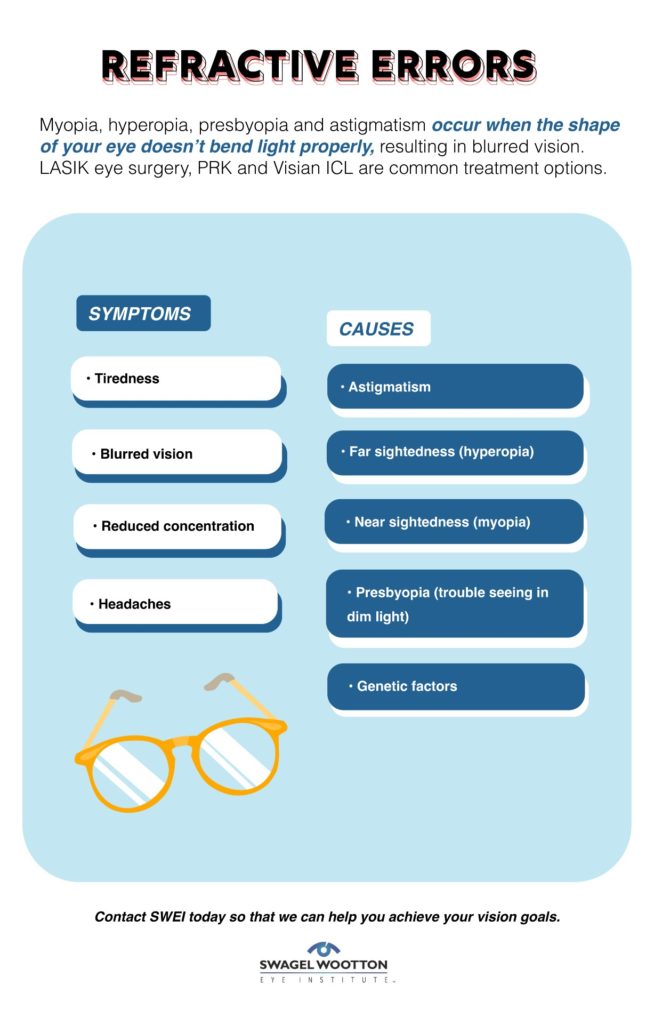
Most people suffer some form of vision refractive errors in their lifetime. Our eye care experts can diagnose your refractive errors and provide multiple courses of treatment to improve your vision. Learn about the symptoms, causes and treatment options below.
Symptoms of Refractive Errors
Symptoms vary depending on the type and severity of the refractive error but may include the following:
- Tiredness
- Headaches
- Blurred vision (either close up or in the distance)
- Reduced concentration
Causes of Refractive Errors
Causes of refractive errors include:
- Astigmatism
- Far sightedness (hyperopia)
- Near sightedness (myopia)
- Presbyopia (trouble seeing in dim light); loss of near focus (accommodation) due to age
- Genetic factors
Treatment of Refractive Errors
When your eyes cannot focus images on the retina, you may develop refractive errors. These conditions develop in childhood or at any age. If you have a family history of refractive errors, you’re more likely to develop them yourself. Each type of refractive error has unique causes and treatments. Astigmatism results when the lens or cornea curves too much in one direction resulting in an oval shape. Longsightedness is caused by a flattened cornea resulting in a focal point behind the retina. Presbyopia most commonly occurs as a part of aging and makes it difficult to see objects in dim light and read fine print. Short sightedness results from over curvature of the cornea resulting in a focal point in front of the retina.
Treatment options for these vision problems include eyeglasses, contacts, and LASIK surgery. If you decide to wear eyeglasses, spherical lenses can correct your vision for myopia and hyperopia. Concave lenses improve nearsightedness and convex lenses improved farsightedness. For astigmatism, we can fit you with cylindrical lenses. Contact lenses for each of these conditions also exist. LASIK Surgery can be used to treat hyperopia, myopia, and astigmatism. The doctor uses an excimer laser to reshape the cornea and correct refractive errors. In some cases, cataract surgery can improve your astigmatism as well. To learn more about the specific treatment types for these diverse refractive errors, contact Swagel Wootton Eye Institute for an exam and consultation.
If you have astigmatism, longsightedness, shortsightedness or other refractive errors, it doesn’t necessarily mean you have to wear contacts or depend on glasses. It makes sense to meet with eye care specialists in Arizona to find out if you’re a good candidate for LASIK eye surgery in Phoenix.
3. Cataracts
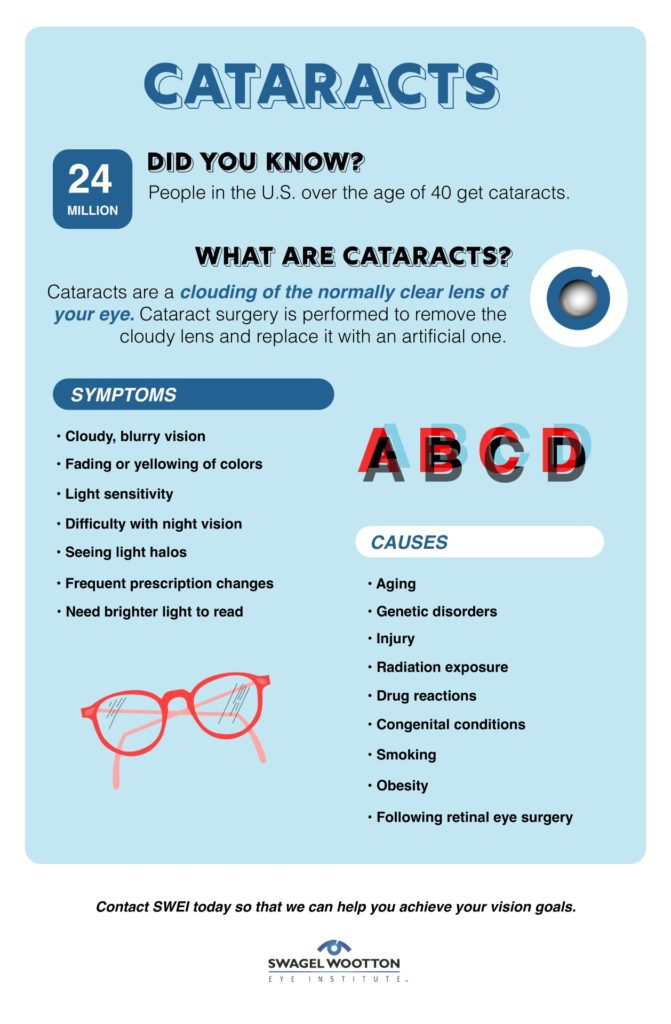
If you begin to have clouded vision or notice the fading or yellowing of colors, you may have cataracts. Learn more about the symptoms, causes and treatment of cataracts.
Symptoms of Cataracts
Common symptoms of cataracts include:
- Clouded, blurred vision
- Fading or yellowing of colors
- Light sensitivity
- Difficulty with night vision
- Seeing light halos
- Frequent prescription changes
- Need to brighter light to read
Causes of Cataracts
Common causes and risk factors for cataracts include:
- Aging
- Genetic disorders
- Injury
- Radiation exposure
- Drug reactions
- Congenital conditions
- Smoking
- Obesity
- Following retinal eye surgery
Treatment of Cataracts
At Swagel Wootton Eye Institute, we can offer several options to improve your vision if you have cataracts. This includes eyeglasses, magnifying lenses and recommendations such as using stronger lighting. However, you’ll eventually need cataract surgery in Phoenix to replace your natural lens with a permanent artificial one. Like any surgical procedure, there are risks involved with cataract surgery. Some people decide to put off surgery for a few years until cataracts diminish their vision significantly. Speaking to our eye doctors in Mesa and Chandler can help you better understand the risk and rewards of scheduling cataract surgery. For example, there are premium lenses you can choose from to improve your eyesight.
Cataracts cause cloudy vision and make it difficult to see in dim lighting. By scheduling cataract surgery with our eye surgeons in Phoenix, you give yourself the best chance at restored or improved vision.
4. Glaucoma
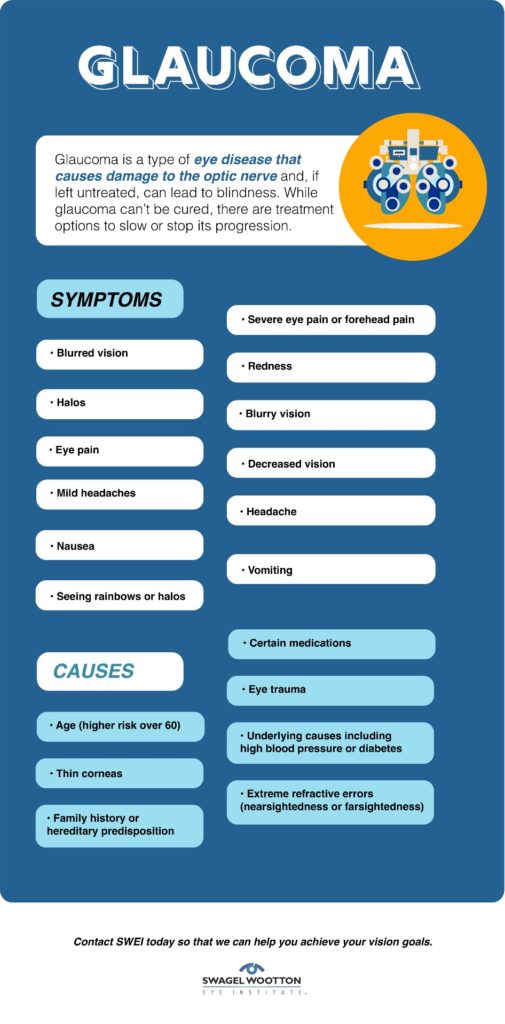
High pressure behind the eyes can cause glaucoma. This condition may not include any symptoms in the early stages, making it important to get your eye pressure tested regularly. Early glaucoma has no symptoms, giving it the moniker: the silent disease. But rare angle closure glaucoma can present the following symptoms.
- Blurred vision
- Halos
- Eye pain
- Mild headaches
Most glaucoma is does not present symptoms until end stage disease when loss of vision occurs. That’s why it’s extremely important to have an annual eye exam to catch early disease before it progresses. Damage to the optic nerve from glaucoma is irreversible. A rarer type of glaucoma (angle closure) can cause the following symptoms.
- Severe eye pain or forehead pain
- Redness
- Blurry vision
- Decreased vision
- Headache
- Nausea
- Vomiting
- Seeing rainbows or halos
Causes of Glaucoma
Causes of high pressure that leads to glaucoma include:
- Age (higher risk over 60)
- Family history or hereditary predisposition
- Underlying causes including high blood pressure or diabetes
- Thin corneas
- Certain medications
- Eye trauma
- Extreme refractive errors (nearsightedness or farsightedness)
Treatment of Glaucoma
The majority of glaucoma cases are treated with topical medication, such as medicated drops. The experienced eye doctors can recommend treatment — ranging from medicated to drops to more advanced techniques to treat glaucoma such as iStent Micro-Bypass, Laser Peripheral Iridotomy and Selective Laser Trabeculoplasty — to slow down the disease.
5. Age-related Macular Degeneration
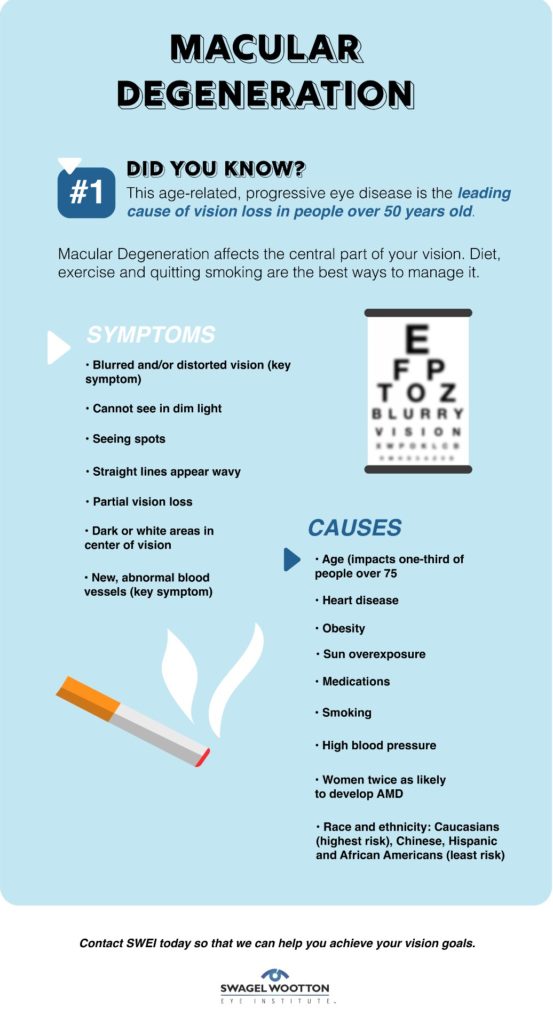
Dry AMD accounts for up to 90% of age-related macular degeneration. Fat and protein called drusen collects under the retina and affects your eye’s ability to process light. Wet ADM affects about 10% of people with age-related macular degeneration. This condition causes extra blood vessels to develop, and these new vessels leak fluids, including blood, that can damage your eye.
Symptoms of Age-related Macular Degeneration
Symptoms of AMD include:
- Blurred and/or distorted vision (key symptom)
- New, abnormal blood vessels (key symptom)
- Cannot see in dim light
- Seeing spots
- Partial vision loss
- Straight lines appear wavy
- Dark or white areas in center of vision
Causes of Age-related Macular Degeneration
Scientists have identified more than 20 linked to age-related macular degeneration. Here are additional causes and risk factors:
- Age (impacts one-third of people over 75)
- Race and ethnicity: Caucasians (highest risk), Chinese, Hispanic and African Americans (least risk)
- Women twice as likely to develop AMD
- Smoking
- High blood pressure
- Heart disease
- Obesity
- Sun overexposure
- Medications
Treatment of Age-related Macular Degeneration
There is no cure for age-related macular degeneration. However, our highly qualified eye doctors at Swagel Wootton Eye Institute use specialized technology to identify AMD, answer your questions about AMD, and can refer patients to a highly qualified retinal specialist in the Phoenix area.
Contact Swagel Wootton Eye Institute today to schedule an appointment for these five common eye conditions or for a full range of vision care in Phoenix. We specialize in cataract and LASIK eye surgery in Phoenix.









